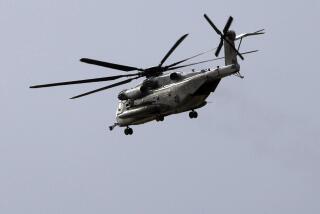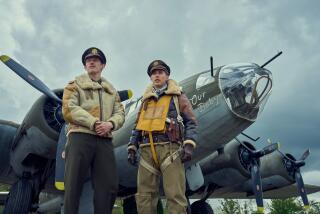Marines Close to the Front, Far From the Action
- Share via
ZORMAT, Afghanistan — As missions go in this war, pumping gas from a big helicopter to a smaller one isn’t among the more glamorous. But this is what Marines from the 13th Expeditionary Unit are doing in the high desert, seven miles west of the front line of the war’s bloodiest battle.
There is little sign of the enemy, though the Marines aren’t so sure about the ragged-looking Afghan locals with Kalashnikovs, just a few hundred shimmery yards across the sand.
“Go on out, take a knee and keep an eye out,” advises Maj. Kevin Moss, the 37-year-old pilot of one of the two CH-53E Super Stallions that landed in this eastern village to refuel and rearm two Cobra gunships combing a nearby ridge for Al Qaeda cavern hide-outs. “You never know who’s paying them,” he says of the distant figures who, according to his security briefing, are “friendlies.”
Out slog a squad of Marines, one with the name Goat on his helmet, to dig holes in the sand. Cpl. Joseph Giannini, a 21-year-old from Bakersfield, eyes a fortification at the edge of the village that looks like a washed-out sand castle. It isn’t exactly what he wants to do in this war, but it’s better than scraping and painting a ship off the coast of Pakistan, as some members of his unit are doing.
“We’ve had a couple of little scares,” Giannini said, when asked for the obligatory war story. “We landed in an LZ [landing zone] the other day and we saw a bunch of people coming over the mountaintop, forming groups. We saw them from 1,000 yards away. All we saw was things shining on them. I didn’t know if it was weapons or not, but I don’t want to take a chance on anyone. They tell us they’re friendly one day, and the next day they’re shooting.”
With its wheels half-buried in the sand, the Super Stallion is a fat target, a cross between a shipping container and a science-fiction locust. It weighs 37,500 pounds empty but is carrying a refueling tank with 4,000 pounds of jet fuel in addition to the 9,000 pounds of fuel in the helicopter’s own tanks, according to Moss.
Bristling with rockets and cannons, the wasp-like Cobras carve showy turns overhead before landing in a sand-blasting whirl. Crew Chief Jason Palmer, 44, of Spokane, Wash., hauls a hose to the tank and fills it in about as much time as it takes to fuel a large SUV. It’s the NASCAR pit stop of aviation. Then the Cobra sweeps off, hugging the terrain, out and up to a series of snowy ridges stamped on the horizon like they were minted on a coin.
Moss (call sign: Algae) and his 29-year-old co-pilot, Capt. Brian Fanning (call sign: Chimpy), came in from Bagram air base, about 100 miles north, flying low enough to flutter laundry and scatter sheep. “In this flat terrain, you’re not going to hear or see us until we’re a mile away,” Moss said. “In the worst case, a guy picks up a SAM [surface-to-air missile], but the time he’s got left to react is too short.”
Nothing like that happens much, though there has been some small-arms fire from villages. “We’re not really allowed to do anything about that,” Palmer says. “You can’t go in and wax a whole city.”
During a flight, though, one of the two door gunners fires off a few rounds into the sand for the benefit of a CNN film crew on board. The sound of the gun is like a chain caught in a metal propeller.
Hours of withering sunshine and sandblast showers go by. Two men leading two mules, a man walking with a camel and a caravan of reporters go by, along with three sets of Afghan government soldiers in beaten-up SUVs heading to the front. Fanning, of Pacific Beach, Calif., shaves in the reflection of the cockpit window. He and pilot Bill Collier (call sign: Slick) whip out their Beachcomber Bar T-shirts and pose for a photograph, the war front a backdrop. Back home, they’ll tack it on the wall of that Pacific Beach watering hole: Welcome to Beachcomber Bar, Afghanistan.
The day’s only test of combat readiness comes when an Afghan soldier starts across the sand toward the helicopters. Moss cradles his M-16. The man sees this and holds out an empty water bottle. They get him a fresh 1 1/2-liter bottle and throw in an MRE--Meals Ready to Eat--packet for good measure. He strolls back to his comrades.
Less than a week before, Moss and other members of the 13th Marine Expeditionary Unit, based in Camp Pendleton, were aboard the amphibious ship Bonhomme Richard in the Arabian Sea. Most of the unit’s members are still aboard, a sore point among Marines who are eager to get into what has amounted to the most concentrated ground action since the war began in October.
Short on fighting, they grouse over food. MREs have gotten fancy. There’s Thai chicken and teriyaki beef. Vegetarian fare usually has the best candy, for no reason known to these men.
You learn to get creative with the ingredients: Take the lemon-lime beverage powder, add some crushed up crackers, sugar, coffee creamer and water, and you have something like a lemon-merengue pie, Palmer says. Cocoa powder, two instant coffee packets and a nondairy creamer get you a field mocha, another adds. Skip the coffee and add some water, and that’s GI pudding.
They say there is a way to use the water-activated heat packets inside the MREs to make bombs that go off like hand grenades. They don’t recommend it in a war zone.
By late afternoon, the men have refueled the two Cobras more than half a dozen times each, and gone aloft to top off their own tanks from a KC-130 refueling plane.
When the mission’s over, the crew and the men who set up the perimeter get back in the Super Stallions and the aircraft lift off, dipping, ducking and banking over a broken country. Nothing happened to the Marines, and that’s something. When they get to Bagram air base, they’ll stroll across the runway. They’ll be sunburned and dirty. They’ll have been to the war zone.
More to Read
Sign up for Essential California
The most important California stories and recommendations in your inbox every morning.
You may occasionally receive promotional content from the Los Angeles Times.











